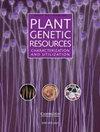高粱(sorghum bicolor [L.][Moench])品种多样性,以确定西非苏丹-萨赫勒地区间作系统中具有对比特征的品种
IF 0.7
4区 生物学
Q3 PLANT SCIENCES
Plant Genetic Resources: Characterization and Utilization
Pub Date : 2022-10-04
DOI:10.1017/s1479262122000168
引用次数: 0
摘要
高粱是撒哈拉以南非洲地区重要的主粮作物。在西非的苏丹-萨赫勒地区,高粱主要与豇豆间作,但这些间作系统面临着生产力低下的问题。本研究的总体目的是鉴定具有不同农业形态和生理性状的高粱品种,以提高间作制度的性能。我们采用了两步方法,包括(i)使用参与式方法鉴定间作系统中感兴趣的品种和植物性状,以及(ii)对50个高粱品种进行农业形态生理表征,以检查感兴趣性状的变异范围。结果表明,地方品种是农民使用最广泛的品种,82.5%的农民认为间作品种选择是重要的。农民提到植株高度、叶片数量和茎粗是重要的考虑因素。方差分析表明,在24个农业形态生理性状中,有一半在品种间存在显著差异。根据茎粗、叶片总数和大小(第1组)、根系性状(深度、生长角度、干物质)和相对叶绿素含量(第2组和第3组)等形态特征,通过分层聚类鉴定出3个主要类群。在此基础上,我们从每3个类群中推荐了几个表现出对比性状的品种,用于评估它们在间作系统中的表现。本文章由计算机程序翻译,如有差异,请以英文原文为准。
Characterizing sorghum (Sorghum bicolor [L.] Moench) varieties diversity to identify those with contrasting traits of interest for intercropping systems in the Sudano-Sahelian zone of West Africa
Sorghum is an important staple crop in Sub-Saharan Africa. In the Sudano-Sahelian zone of West Africa, sorghum is mainly intercropped with cowpea, but these intercropping systems are facing low-productivity problems. The overall aim of this research was to identify sorghum varieties with different agro-morphological and physiological traits that could improve the performance of the intercropping systems. We followed a two-step methodology comprising (i) identification of varieties and plant traits of interest in intercropping systems, using participatory methods, and (ii) agro-morpho-physiological characterization of 50 sorghum varieties, to examine the range of variation in traits of interest. The results show that landraces are the varieties most widely used by farmers, and that 82.5% of farmers consider the variety type they choose for intercropping to be important. Farmers mentioned plant height, number of leaves and stem diameter as important traits to consider. Analysis of variance showed significant differences between varieties for half of the 24 agro-morpho-physiological traits studied. Hierarchical clustering identified three main groups of varieties, distinguished by morphological traits such as stem diameter, total number and size of leaves (group 1), root traits (depth, growth angle, dry matter) and relative chlorophyll content (groups 2 and 3). Based on this classification, we recommend several varieties from each of the three groups, exhibiting contrasting traits, for an assessment of their performances in intercropping systems.
求助全文
通过发布文献求助,成功后即可免费获取论文全文。
去求助
来源期刊

Plant Genetic Resources: Characterization and Utilization
Agricultural and Biological Sciences-Agronomy and Crop Science
CiteScore
2.80
自引率
0.00%
发文量
29
审稿时长
>12 weeks
期刊介绍:
Plant Genetic Resources is an international journal which provides a forum for describing the application of novel genomic technologies, as well as their integration with established techniques, towards the understanding of the genetic variation captured in both in situ and ex situ collections of crop and non-crop plants; and for the airing of wider issues relevant to plant germplasm conservation and utilisation. We particularly welcome multi-disciplinary approaches that incorporate both a technical and a socio-economic focus. Technical aspects can cover developments in technologies of potential or demonstrated relevance to the analysis of variation and diversity at the phenotypic and genotypic levels.
 求助内容:
求助内容: 应助结果提醒方式:
应助结果提醒方式:


